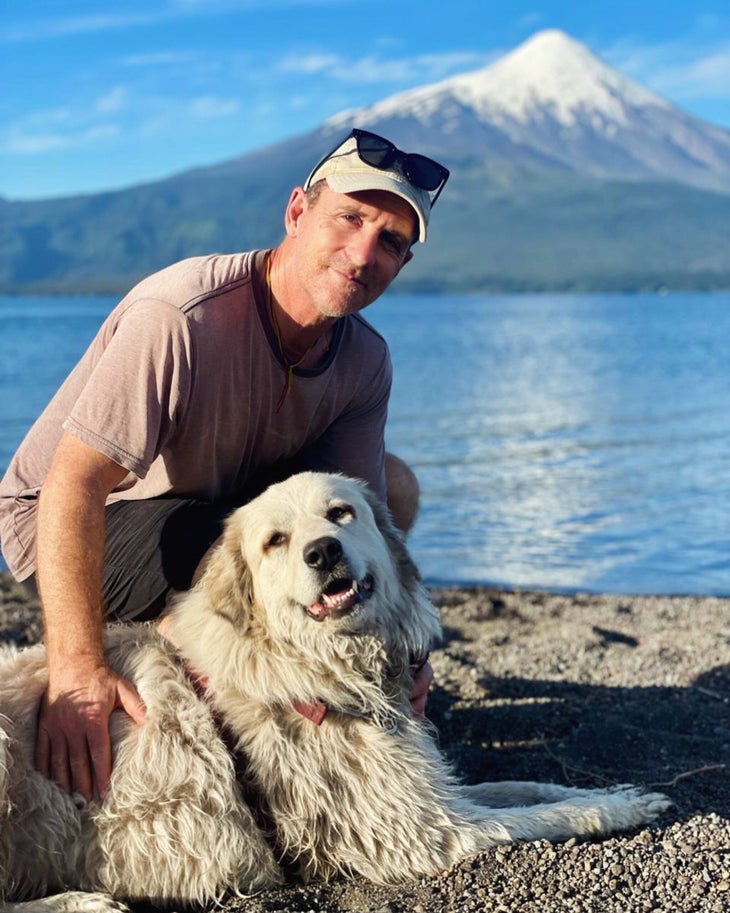If you are drawn instinctively and helplessly to high mountains, then the Nepal Himalayas are something of a holy grail. Home to eight of the world’s ten highest peaks, a dense network of trails, and an unrivaled trekking infrastructure of lodges, guides, and porters, Nepal is perhaps the world’s ultimate hiking destination.
In 20 years of writing guidebooks about the country, I’ve learned that Nepal has far more to offer trekkers than the famous hike to Everest. The world’s highest mountain dominates news headlines, sucking up all the oxygen in the room. But Everest has serious downsides—notably high-season overcrowding, the hassles (and dangers) of flying into Lukla airport, and the dangers of traveling to such high altitude. Most tour leaders agree that Nepal’s best trekking experiences actually remain outside the Everest region.
So, where else should you trek in Nepal? Choosing the perfect trail depends largely on your priorities. If you want a logistically simple, budget-friendly hike and, and you also enjoy the social side of trekking, then opt for a teahouse route like the Annapurna Sanctuary or Langtang Valley. On these trails you can get meals and a bed en route—you can also spend the evenings trading tales with a collection of like-minded travelers.
If you prefer a quieter experience, as I do, try a less popular teahouse route such as around the one that circumnavigates 26,781-foot Manaslu, perhaps in shoulder season. I’d also suggest a camping trek like the ones to Kangchenjunga or Makalu Base Camp, generally organized with porters and a guide, which allows you to soak up achingly beautiful landscapes in splendid isolation. If village culture and Buddhist monasteries are more your thing, then head to the Tibetan regions of Mustang or Dolpo.
And if committing to a single Nepal trek feels like having to choose your favorite child, don’t worry. Nepal’s unrivaled combination of spectacular Himalayan scenery, logistical ease, and charming people means that you are almost certain to come back for another round. So, if you are finally ready to look beyond Everest, here are our favorite other treks in Nepal.
Around Manaslu: Nepal’s Best Teahouse Trek
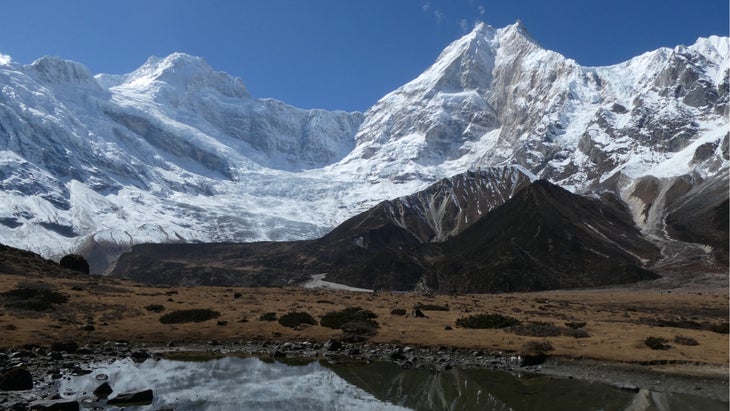
Duration: 11 to 12 days
When to Go: April to May, October t0 November
Maximum Elevation: 16,785″
Permit: U.S. $75-100 permit, plus Manaslu Conservation Area and Annapurna Conservation Area (ACAP) permits, $22 each.
Why we love it: If only there was one trail that combined magnificent high-altitude scenery, traditional Tibetan-style villages and the comfortable lodges that Nepal is famous for, but without the crowds of Everest and the Annapurnas. Well, don’t tell anyone, but Manaslu has all of that, and I feel totally justified in calling it Nepal’s single best teahouse trek. Highlights include waterfall-lined gorges, epic views of the world’s tenth highest peak, the snowfields of the Larkye La pass, and some of the Himalaya’s most beautiful glacial lakes. The route’s optional detour to Pungyen Glacier might well be my favorite day hike in the entire Himalaya.
Need to know: Cramped buses and shared jeeps run to the trailheads, but for sanity’s sake, it’s worth splurging to hire your own jeep. Bring Microspikes for the often icy crossing of the Larkye La pass.
Kangchenjunga North & South: Trek to the World’s Third Highest Peak
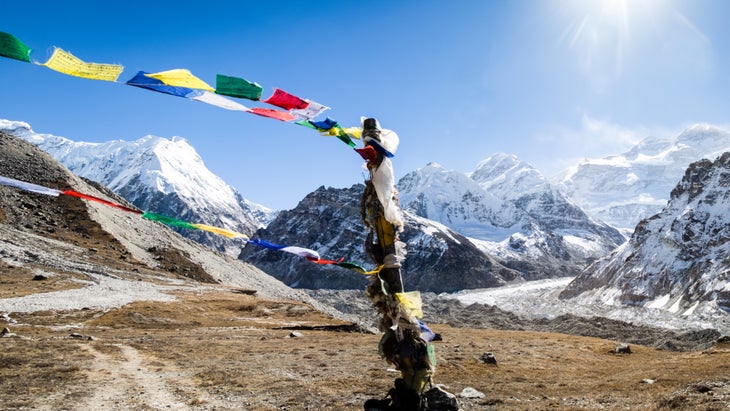
Duration: 15 to 20 days
When to Go: March to May, October to November
Maximum Elevation: 16,863″
Permits: U.S. $20 per week, plus $22 conservation area fee.
Why we love it: Way out in the far eastern corner of Nepal, on the border with India’s Sikkim province, lies a monster: 28,169″ Kangchenjunga, the world’s third highest peak (presumed the world’s highest until the fifties). Getting here takes time but the rewards are immense, from traditional Limbu villages and stunning springtime rhododendron blooms, to high yak pastures and neck-craning views of Kangchenjunga’s five sacred summits. Separate routes lead to the southern and northern base camps, but the best itinerary combines both by crossing the Mirgin La pass in one incredible trek.
Need to Know: The simple local teahouses that line the routes offer basic food and porter accommodation, meaning you can cut down on heavy supplies such as fuel and food and turn this into a hybrid teahouse-camping trek. Getting to the trailhead involves some effort: most likely a flight to Bhadrapur and then a day-long jeep ride.
Langtang Valley: The Best Bang for Your Buck
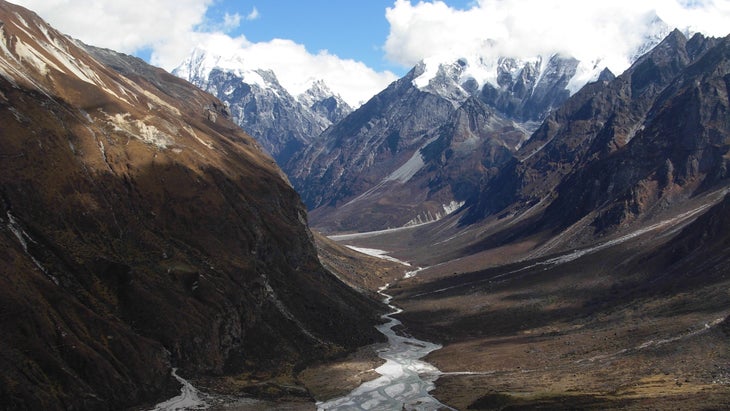
Duration: 7 to 9 days
When to Go: September to May
Maximum Elevation: 12,697″
Permits: Langtang National Park fee $22
Why we love it: Nepal’s third most popular trekking area is just a day’s bus ride from the capital Kathmandu and packs a powerful scenic punch for a relatively short time investment. In a week, you’ll climb through lush forests up into alpine pastures, crossing the ruins of former Langtang village, destroyed by a landslide during Nepal’s catastrophic 2015 earthquake.
The real highlight of the trek is basing yourself in the highest village of Kyanjin Gompa for several days of awesome radial day hikes, up to dramatic glacier and lake viewpoints or yak pastures just a stone’s throw from the Tibetan border. It’s hard to imagine a better week in the mountains.
Need to know: Good lodges line the Langtang Valley, offering food and accommodation every couple of hours. Kyangjin Gompa even offers a bakery-cafe and locally-made nak cheese (a nak is a female yak). Combo options with nearby Gosainkund and the community-based Tamang Heritage Trail make for great extensions if you have time.
Gosainkund & Helambu: Sacred Lakes & Himalayan Panoramas
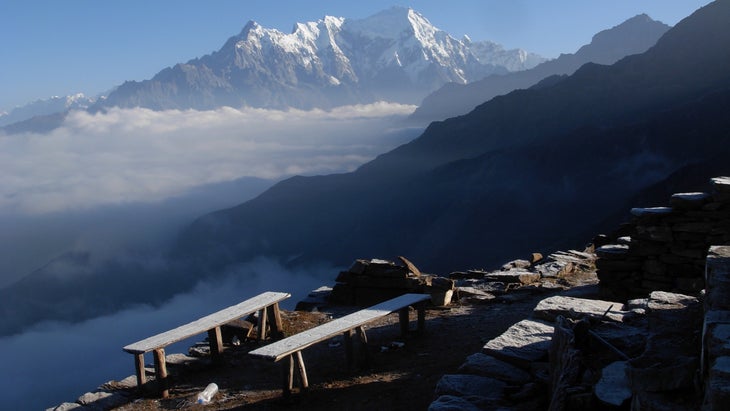
Duration: 6 days
When to Go: April to May, October t0 November
Maximum Elevation: 15,124″
Permits: Langtang National Park fee U.S. $22
Why we love it: A great add-on to the Langtang Valley trek, this underrated walk climbs past panoramic Himalayan views into the high bowl and dozen sacred lakes of Gosainkund. Be sure to budget half a day to explore the main lake, adorned with Buddhist cairns and Hindu tridents, as well as some of the lesser-visited tarns. During the August monsoon, thousands of sadhus (holy men) make the trek here to celebrate the lake’s associations with the Hindu god Shiva.
From Gosainkund the trail crosses the rugged pass of the Laurebina La and then plummets through wild valleys to reach big Himalayan views at Tharepati ridge. From here, it’s a day’s descent through the rhododendron forests of Helambu to the roadhead at Kutumsang.
Need to Know: This is one trek where you have to watch out for altitude sickness, as the first few days see rapid altitude gain. Consider acclimatizing on the Langtang Valley trek first. Instead of ending at Kutumsang, you can continue for another two or three days, descending through Shivapuri National Park to enter the Kathmandu Valley on foot, a stone’s throw from the yak steaks and two-for-one cocktails of Thamel.
Upper Mustang: A Former Himalayan Kingdom
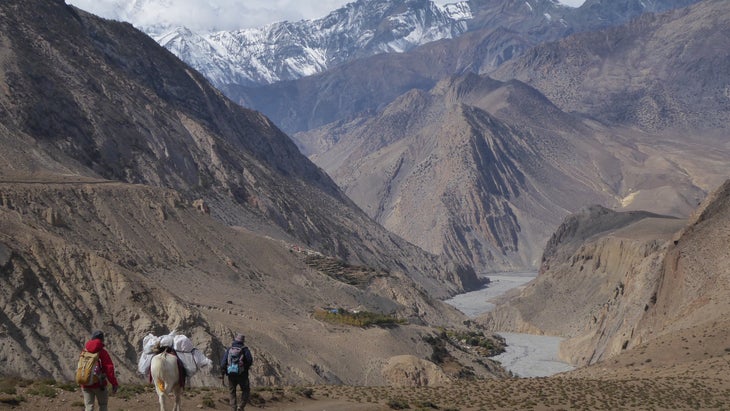
Duration: 10 days
When to Go: May to October
Maximum Elevation: 14,190″
Permits: U.S. $500 for the first ten days, then $50 per day
Why we love it: A thumb of Nepal sticking into the Tibetan plateau, the former Himalayan kingdom of Mustang, off-limits to foreigners until the nineties, represents one of the world’s last pockets of unfettered traditional Tibetan culture. The scenery is more Tibet than Nepal—a dusty, treeless, high desert of Martian landscapes, and fantastical, eroded valleys. It’s also home to some of the finest Buddhist murals in the Tibetan world, in the spectacular temples of the walled capital of Lo Manthang, but also hidden in cliffside cave complexes. This is one trek where culture ranks higher than high mountain scenery.
Need to know: An unpaved road popular with Nepali motorcyclists now connects Jomsom airport on the Annapurna Circuit to Lo Manthang and the China border beyond, but hiking trails avoid most of the road, especially if, like I did, you return down the roadless eastern side of the valley, via Tange and Tetang. Here’s another tip: splash out on the high-end Royal Mustang Resort in Lo Manthang, belonging to the former royal family of Mustang, but book well in advance if coming for the spectacular masked dances of the Tiji festival in May.
Annapurna Sanctuary: The Best Annapurna Teahouse Trek
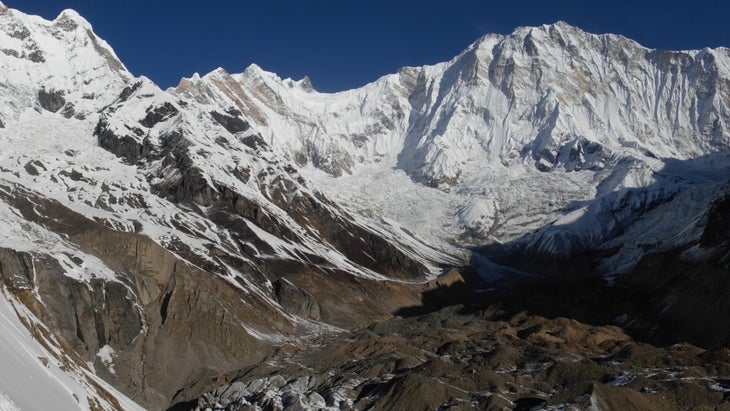
Duration: 10 days
When to Go: April to May, October t0 November
Maximum Elevation: 13,345″
Permits: $22 ACAP permit, best purchased before departure
Why we love it: The most popular of the routes winding into the stunning Annapurna massif in central Nepal, the sanctuary is a classic Himalayan journey. It starts in sultry rice fields and climbs through ethnic Gurung villages until entering a breathtaking high mountain cul-de-sac, surrounded by the horizon-filling peaks of Machhapuchhare, Hiunchuli, and Annapurna’s epic south face (26,545″).
Need to Know: While the long-popular Annapurna Circuit has been transformed by roads along 70 percent of its course (the reason it’s not listed here), the Sanctuary remains road-free. The clearly marked trails, excellent teahouses, and relatively short duration make it an understandably popular trail, so try to visit toward the beginning or end of the season.
Tarap Valley Loop: A Taste of Tibetan-style Dolpo
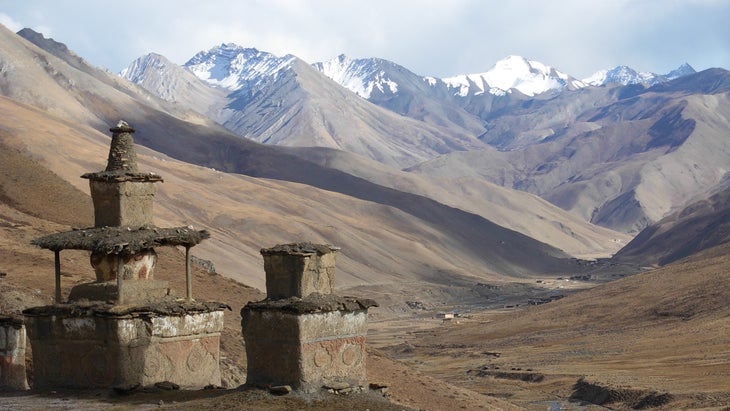
Duration: 9 Days
When to Go: May to October
Maximum Elevation: 17,356″
Permits: $20 for the first week, then $5 per day
Why we love it: The remote western region of Dolpo ranks with Mustang as one of the Himalaya’s most fabled and little-visited regions. This Tarap Valley trek stays in lower Dolpo, enjoying much of the same traditional Tibetan culture and unspoiled wilderness of remoter upper Dolpo, but without the latter’s eye-watering $500 permit. Highlights include timeless villages, iconic stupas, and the monasteries around Do Tarap village, plus the stunning high passes of the Numa La and Baga La and a night beside Nepal’s most beautiful lake, Phoksumdo. Only a few agencies offer this trek, but it’s a real hidden gem.
To venture even further off the beaten track, use Phoksumdo as the jumping off point for an expedition into upper Dolpo, following in the footsteps of George Schaller and Peter Matthiessen to reach the crystal monastery of Shey, as described in the Matthiessen’s classic travelogue The Snow Leopard.
Need to know: This is a camping trek requiring a restricted area permit, so you’ll have to trek with a registered guide and, most likely, porters to help carry your equipment. Start the trek by flying into Juphal airstrip from either Kathmandu or Nepalganj.
Makalu Base Camp: The Heart of the High Himalaya
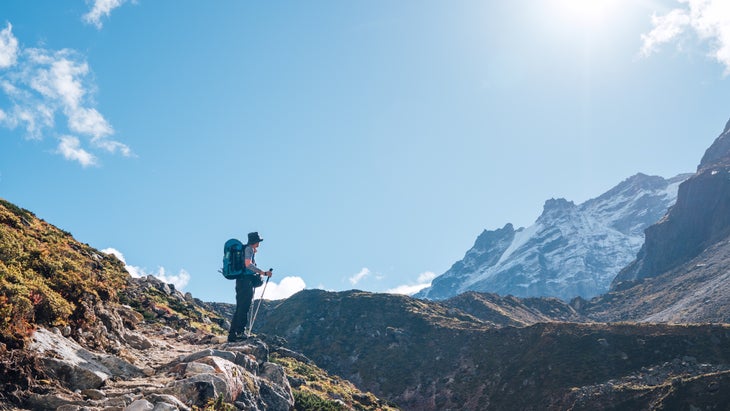
Duration: 13 Days
When to go: March to May, October t0 November
Maximum Elevation: 16,404″
Permits: $20 per week, plus $22 Makalu Barun National Park fee
Why we love it: This rugged trek remains deliciously off the beaten trek. Despite being the world’s fifth highest peak (at 27,762″), there are so many awesome mountains in Nepal that many people haven’t even heard of Makalu. The route takes you from the Arun river, over ridges, pastures, and the Shipton pass, to follow the Barun valley into the very heart of the high Himalaya. The astonishing views of Makalu, Lhotse, Baruntse, and Everest’s Kangshung face are as dramatic as you’ll find anywhere in the world. The only downside: you have to return the way you came.
Need to know: Simple trekking lodges line the route in high season but they do fill up, so come with a backup tent. Access is via a prop flight to Tumlingtar.
Annapurna North Base Camp: Historic, Short, and Spectacular
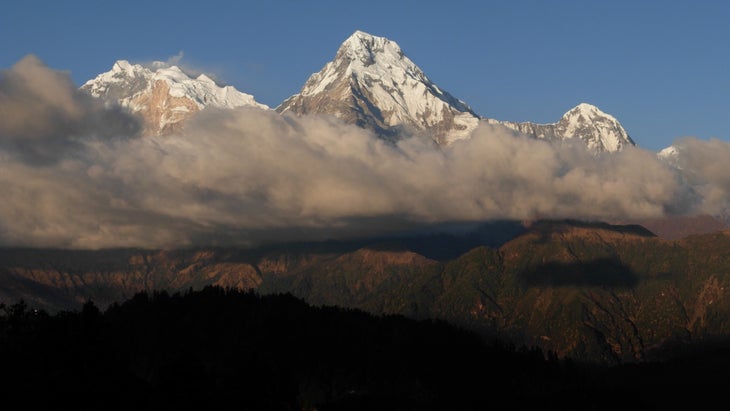
Duration: 6-7 Days
When to Go: March to May, October to November
Maximum Elevation: 14,124″
Permits: $22 ACAP permit
Why we love it: Here’s a wild card. Not many people know about this short but spectacular camping trek that leaves the Annapurna crowds in the dust to follow Maurice Herzog’s classic 1950 expedition route to Annapurna I (the first time an 8,000 meter peak was summited—read his adventure classic Annapurna). No other trek gets you so close to such epic mountains so quickly. A three-day valley approach drops you at Narchang Lake and Annapurna North Base Camp, from where astounding day hikes lead to a series of high base camps and close-up mountain views of the Annapurna, Tilicho, and Nilgiri peaks. This is high mountain heaven, served with a deep slice of climbing history.
Need to know: You’ll need a 4WD from Pokhara or Tatopani to take you up the spectacular mountain road to the trailhead.
Bradley Mayhew is a travel writer specializing in the mountains of Asia, and is the author of Lonely Planet guides to Trekking in the Nepal Himalaya, Nepal, Bhutan, Tibet, Central Asia and others.
